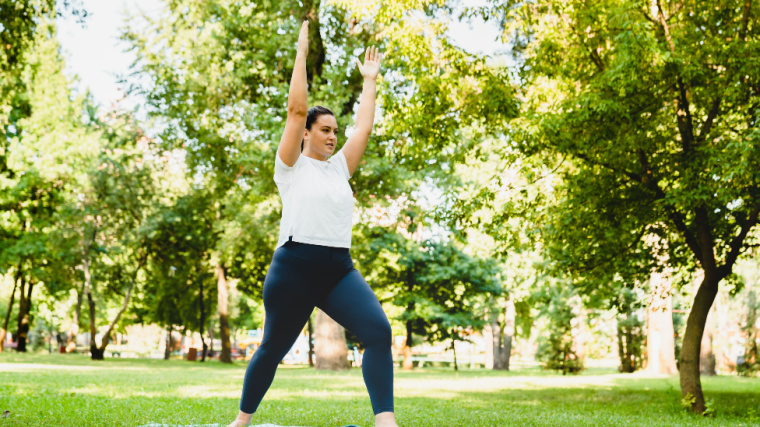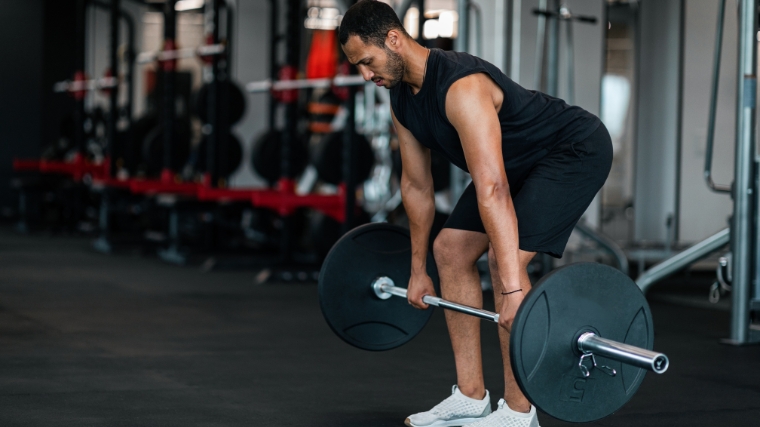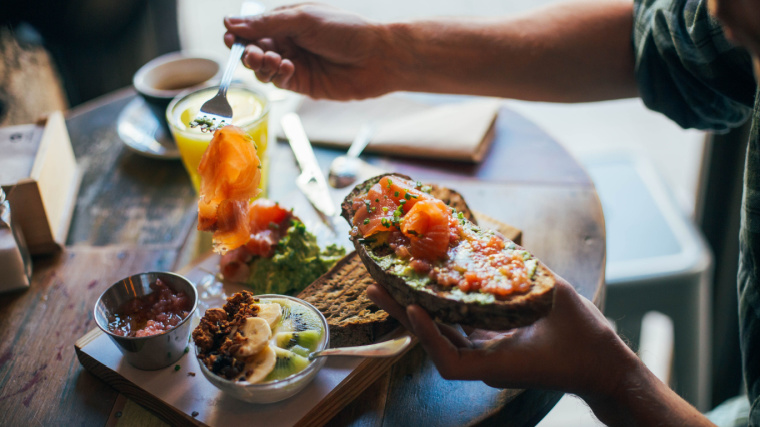If you’ve noticed that you tend to lose fat faster in certain areas — like your arms, legs, or waist — while others take a bit longer, you’re not alone. While body fat levels are largely governed by energy balance, or calories in versus calories out, the distribution of body fat depends on a wide range of variables.
Genetics, hormones, access to high-quality nutrition and healthcare, and environmental and lifestyle factors can all determine whether you carry most of your body fat around your waistline or your hips. These fat distribution patterns, in turn, impact your health in different ways.

Unlike the fat around your hips, belly fat has been associated with a higher risk of cardiovascular disease, making fat loss in this area potentially more than just a cosmetic change. So, what causes fat gain in this area, and what are the best ways to manage it?
What Is Body Fat?
Body fat, or adipose tissue, is the body’s way of storing energy. It consists primarily of adipose cells, which are filled with triglycerides. Just like the fats in your diet, the triglycerides in your adipose cells provide energy — which is measured in calories.
Body fat contains very little water, making it a densely concentrated source of calories that can be used for energy when your dietary intake is too low. (1)
Fat storage largely occurs when you take in more calories (or energy) than you need to maintain your current weight. Likewise, when you are in a calorie deficit, you tend to burn fat because it’s broken down to meet your energy needs. (1)
What Are Fat Distribution Patterns?
Fat distribution generally falls into two categories: mostly around the midsection (an android pattern) or mostly around the hips (a gynoid pattern). These are sometimes nicknamed “apple-shaped” and “pear-shaped” body types. (2)
Overall body fat has two main categories. The fat stored around the hips and thighs is subcutaneous fat, which means it’s located between the skin and the muscle. Abdominal fat (or “belly fat”) is often both subcutaneous and visceral, or around the internal organs. (2)

[Read More: Best Fat Burners]
Because some of the fat surrounds the internal organs, this android pattern is linked to a higher risk of cardiovascular disease and all-cause mortality, whereas a gynoid pattern is somewhat protective in people with or without obesity. (2)
What Causes Belly Fat?
Android and gynoid patterns are primarily dictated by genetics and sex hormones, but lifestyle also plays a role. Genetics, hormones, environment, and lifestyle factors will also impact how much your android or gynoid fat pattern affects your health. (2)(3)(4)(5)(6)(7)(8)(9)
Genetics
Genetics may account for 40 to nearly 90 percent of your fat distribution pattern, making it potentially the most influential factor. Studies that compare different ethnicities have found that due to genetic factors — which are influenced by social environments — people of certain races and ethnicities may be more susceptible to android-associated health risks like heart disease or type 2 diabetes. (3)(4)(5)
Sex Hormones
During puberty, sex hormones have a significant impact on body fat distribution patterns and body composition, predisposing most cisgender men to developing an android shape and most cisgender women to a gynoid shape. (6)(7)
[Read More: The Best Ashwagandha Supplements for Sleep, Testosterone, and More]
During menopause, cis women experience a redistribution of body fat due to the lower levels of estrogen and may begin developing more of an android shape. This change also brings about an increased risk of cardiovascular disease. (8)
Environment & Lifestyle
Both your environment and your lifestyle can affect gene expression. This process, also known as epigenetics, can’t change your DNA, but it can influence whether or not you develop some of the traits or conditions that you’re predisposed to, like an android fat pattern. (3)(9)
For example, living in an area that isn’t walkable can increase sedentary behaviors, and living in a food desert can limit access to fresh fruits and vegetables. Without the protective influence of physical activity and adequate nutrition, you’re more susceptible to accumulating visceral fat and its associated health risks. (9)

[Read More: The Best Fat Burners for Women for Value, Appetite Suppression, and More]
Sleep and stress levels can also affect fat distribution. Shorter sleep durations are linked to higher levels of visceral fat, while chronic stress is associated with higher levels of cortisol, often referred to as a “stress hormone.” (10)(11)
Cortisol regulates a number of metabolic processes, including both fat loss and storage. There’s some evidence cortisol may also promote an android fat pattern, although this isn’t a consistent finding across studies. The relationship between stress and body fat is too complex to be explained by cortisol alone. (11)
Can You Target Belly Fat?
You’ve probably seen all sorts of ads about targeting belly fat with various supplements, unusual gadgets, or hundreds of crunches.
While the myth of spot fat reduction may not be a complete wash — at least one study has shown that it can occur after intense bouts of combined resistance training and aerobic exercise — it is largely mythical and probably isn’t the best use of your time and energy. (12) You still need to exercise and be in a calorie deficit to spot reduce, so if you’re putting in the work anyway, why not work on your overall body composition?

[Read More: The 11 Best Fat Burner Pills That Work]
That being said, whether or not you decide to pursue weight loss, you can still reduce visceral fat by adding resistance training or moderate to vigorous aerobic exercise at least three times per week. You read that correctly: if you’re exercising enough, you don’t need a calorie deficit to reduce the amount of fat stored around your organs. (13)(14)
Tips for Losing Body Fat
Now that we’ve cleared up some of the common myths and misconceptions around belly fat, you might be wondering what steps to take next.
You might think that you need to start tracking macros, overhaul your diet, and find a personal trainer right away. While those might work for a lot of people, they aren’t necessary. It’s possible to achieve intentional weight loss without counting macros or calories.
[Read More: How to Calculate Your Macronutrients for Weight Loss]
It’s also possible to improve your health and wellness in a weight-neutral manner, which focuses on behavioral lifestyle changes like exercising, managing stress, and eating a nutritious, healthy diet without tracking body weight or pursuing intentional weight loss. (15)
Whatever approach you choose, you want the results to last, and sustainable results can only be achieved through sustainable changes. So, here are some things to keep in mind.
Try to Sleep More and Stress Less
Before you look into ways to optimize your morning routine or which of the latest weight loss supplements you should buy, take stock of your sleep habits and stress levels. These are influential factors that make your intended behaviors easier or harder to achieve.
First, how much sleep are you getting? If you’re regularly getting less than eight hours per night, you’re starting the day in a sleep-deprived state. This can affect your energy levels, but it also affects your appetite and potentially your fat distribution. Of course, getting more sleep is the goal; the process will entail making adjustments to the earlier parts of your day and your bedtime routine. (10)(11)
[Read More: 8 Best Appetite Suppressants to Burn Fat, Boost Metabolism, and More]
Chronic stress is linked to weight gain over time. If you’re spending most of your day feeling both tired and wired, it’s worth looking into more effective methods for managing difficult emotions, like working with a mental health professional. It could also be a signal that it’s time to evaluate your work-life balance (which may also support your goal to get more sleep). (11)
Get (And Stay) Active Throughout the Day
Physical activity is a cornerstone of long-term weight management. Strength training and aerobic exercise are effective ways to reduce visceral fat and improve body composition, even if you aren’t in a calorie deficit.
But you don’t have to do high-intensity interval training or HIIT workouts to increase muscle mass, get your heart rate up, and potentially reduce your waist circumference. If you aren’t keen on joining a gym or starting a workout program, you can still benefit from increasing your non-exercise activity level. (16)
[Read More: The 16 Best Pre-Workout Supplements]
Whether it’s washing the car, sweeping the floors, taking the stairs, or going the long way from your cubicle to the bathroom, physical activity increases your energy expenditure, which can make it easier to achieve a calorie deficit. Don’t neglect an opportunity for a little bit of movement just because it isn’t a whole cardio workout.
Eat a Balanced Diet (That You Actually Enjoy)
Most of the time, try to eat nutrient-dense foods like vegetables, fruits, whole grains, legumes, and lean proteins and add health-promoting fats like olive oil, nuts, and seeds. They’re usually less energy-dense but more filling than ultra-processed snack foods (like cookies or chips) and provide health benefits far beyond weight management. (17)
These minimally processed foods also promote cardiometabolic health, reduce the risk of various cancers, and support gut health. They may also contain less absorbable energy than more processed foods, making it easier to achieve a calorie deficit. (18)

[Read More: The Best Healthy Fast Food Options at the Most Popular U.S. Chains]
It’s a good idea to limit sugary drinks, like sodas or frappes, since they don’t provide vitamins or minerals and they contribute a lot of calories without much satisfaction. Plus, beverages are even less filling than solid snack foods. (19)
Stay Flexible
Keep in mind, though, that diets with strict rules are counterproductive and almost impossible to sustain, so there’s no need to eliminate sweets or snack food. Fat loss only requires that you eat fewer calories than you need to maintain your current weight; there’s no reason to make those calories miserable to eat. (20) (That would undermine your foundational stress management goal, too!)
Being flexible about your food choices can also help you maintain your prudent dietary pattern while you’re traveling or just busier than usual. You won’t be “breaking the rules” if you grab a chicken sandwich from a fast food restaurant, and you’ll know that sometimes downing a protein shake with a piece of fruit and a handful of nuts is good enough (because it doesn’t have to be perfect).
Slow and Steady
To make any changes to your body composition, make sure that the changes you’re incorporating into your lifestyle are gradual, sustainable, and even enjoyable. The more likely you are to keep up certain habits surrounding body recomposition, the more likely you are to achieve goals that will last (whether that’s an increase in strength, muscle gain, or losing belly fat).
FAQs
Such a loaded topic as belly fat is bound to yield a lot of questions. Here are some rapid-style answers.
You can’t control your fat distribution pattern, so if you tend to gain belly fat first, it may be one of the last places where you notice fat loss. However, you can lose visceral fat by exercising more — which is likely to yield health improvements — and a calorie deficit can support further fat loss around your midsection and the rest of your body.
While it may not be noticeable from the outside, resistance training and aerobic exercise can reduce the amount of visceral fat you have. To reduce your body fat, including the fat around your midsection, you need to create a calorie deficit, which can be achieved by increasing physical activity, reducing energy intake, or a combination of both.
Some foods — like sugar and carbs — have a bad reputation in diet culture. There are no foods that need to be avoided to lose belly fat. However, ultra-processed foods and sugary drinks are often high in calories and easy to overconsume since they aren’t very filling. While all foods can fit in moderation, they may make it difficult to regulate your energy intake.
If you’re getting less than eight hours of sleep per night, you could benefit from getting more sleep, since short sleep durations are linked to higher levels of visceral fat.
Sleep deprivation may lead you to move less and eat more during the day, potentially putting you in a caloric excess. If adequate sleep helps you feel more energized during the day, you’ll likely have an easier time engaging in the activities necessary for fat loss.
References
- National Academies of Sciences, Engineering, and Medicine, Health and Medicine Division, Food and Nutrition Board, & Committee on the Dietary Reference Intakes for Energy. (2023). Factors affecting energy expenditure and requirements. In Dietary Reference Intakes for Energy (p. 4). National Academies Press.
- Ma, W., Zhu, H., Yu, X., Zhai, X., Li, S., Huang, N., Liu, K., Shirai, K., Sheerah, H. A., & Cao, J. (2023). Association between android fat mass, gynoid fat mass and cardiovascular and all-cause mortality in adults: NHANES 2003-2007. Frontiers in cardiovascular medicine, 10, 1055223.
- Sun, C., Kovacs, P., & Guiu-Jurado, E. (2021). Genetics of Body Fat Distribution: Comparative Analyses in Populations with European, Asian and African Ancestries. Genes, 12(6), 841.
- Yaghootkar, H., Whitcher, B., Bell, J. D., & Thomas, E. L. (2020). Ethnic differences in adiposity and diabetes risk – insights from genetic studies. Journal of internal medicine, 288(3), 271–283.
- Carter, J. L., Abdullah, N., Bragg, F., Murad, N. A. A., Taylor, H., Fong, C. S., Lacey, B., Sherliker, P., Karpe, F., Mustafa, N., Lewington, S., & Jamal, R. (2023). Body composition and risk factors for cardiovascular disease in global multi-ethnic populations. International journal of obesity (2005), 47(9), 855–864.
- Yang, Y., Xie, M., Yuan, S., Zeng, Y., Dong, Y., Wang, Z., Xiao, Q., Dong, B., Ma, J., & Hu, J. (2021). Sex differences in the associations between adiposity distribution and cardiometabolic risk factors in overweight or obese individuals: a cross-sectional study. BMC public health, 21(1), 1232.
- Boulet, N., Briot, A., Galitzky, J., & Bouloumié, A. (2022). The Sexual Dimorphism of Human Adipose Depots. Biomedicines, 10(10), 2615.
- Kodoth, V., Scaccia, S., & Aggarwal, B. (2022). Adverse Changes in Body Composition During the Menopausal Transition and Relation to Cardiovascular Risk: A Contemporary Review. Women’s health reports (New Rochelle, N.Y.), 3(1), 573–581.
- Mahmoud A. M. (2022). An Overview of Epigenetics in Obesity: The Role of Lifestyle and Therapeutic Interventions. International journal of molecular sciences, 23(3), 1341.
- Giannos, P., Prokopidis, K., Candow, D. G., Forbes, S. C., Celoch, K., Isanejad, M., Pekovic-Vaughan, V., Witard, O. C., Gabriel, B. M., & Scott, D. (2023). Shorter sleep duration is associated with greater visceral fat mass in US adults: Findings from NHANES, 2011–2014. Sleep Medicine, 105, 78-84.
- Incollingo Rodriguez, A. C., Epel, E. S., White, M. L., Standen, E. C., Seckl, J. R., & Tomiyama, A. J. (2015). Hypothalamic-pituitary-adrenal axis dysregulation and cortisol activity in obesity: A systematic review. Psychoneuroendocrinology, 62, 301-318.
- Scotto di Palumbo, A., Guerra, E., Orlandi, C., Bazzucchi, I., & Sacchetti, M. (2017). Effect of combined resistance and endurance exercise training on regional fat loss. The Journal of sports medicine and physical fitness, 57(6), 794–801.
- Khalafi, M., Malandish, A., Rosenkranz, S. K., & Ravasi, A. A. (2021). Effect of resistance training with and without caloric restriction on visceral fat: A systemic review and meta-analysis. Obesity reviews : an official journal of the International Association for the Study of Obesity, 22(9), e13275.
- Vissers, D., Hens, W., Taeymans, J., Baeyens, J. P., Poortmans, J., & Van Gaal, L. (2013). The effect of exercise on visceral adipose tissue in overweight adults: a systematic review and meta-analysis. PloS one, 8(2), e56415.
- Dugmore, J. A., Winten, C. G., Niven, H. E., & Bauer, J. (2020). Effects of weight-neutral approaches compared with traditional weight-loss approaches on behavioral, physical, and psychological health outcomes: A systematic review and meta-analysis. Nutrition Reviews, 78(1), 39–55.
- Ogden, L. G., Stroebele, N., Wyatt, H. R., Catenacci, V. A., Peters, J. C., Stuht, J., Wing, R. R., & Hill, J. O. (2012). Cluster analysis of the national weight control registry to identify distinct subgroups maintaining successful weight loss. Obesity, 20(10), 2039–2047.
- Pérez-Escamilla, R., Obbagy, J. E., Altman, J. M., Essery, E. V., McGrane, M. M., Wong, Y. P., Spahn, J. M., & Williams, C. L. (2012). Dietary energy density and body weight in adults and children: a systematic review. Journal of the Academy of Nutrition and Dietetics, 112(5), 671–684.
- Corbin, K. D., Carnero, E. A., Dirks, B., Igudesman, D., Yi, F., Marcus, A., Davis, T. L., Pratley, R. E., Rittmann, B. E., Krajmalnik-Brown, R., & Smith, S. R. (2023). Host-diet-gut microbiome interactions influence human energy balance: a randomized clinical trial. Nature communications, 14(1), 3161.
- Hall, K. D., Ayuketah, A., Brychta, R., Cai, H., Cassimatis, T., Chen, K. Y., Chung, S. T., Costa, E., Courville, A., Darcey, V., Fletcher, L. A., Forde, C. G., Gharib, A. M., Guo, J., Howard, R., Joseph, P. V., McGehee, S., Ouwerkerk, R., Raisinger, K., Rozga, I., … Zhou, M. (2019). Ultra-Processed Diets Cause Excess Calorie Intake and Weight Gain: An Inpatient Randomized Controlled Trial of Ad Libitum Food Intake. Cell metabolism, 30(1), 67–77.e3.
- Linardon, J., & Mitchell, S. (2017). Rigid dietary control, flexible dietary control, and intuitive eating: Evidence for their differential relationship to disordered eating and body image concerns. Eating behaviors, 26, 16–22.
Featured Image: ALL best fitness is HERE / Shutterstock